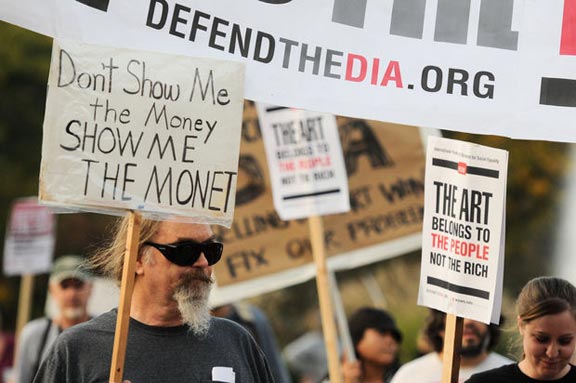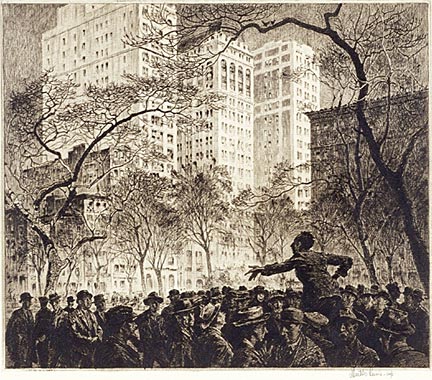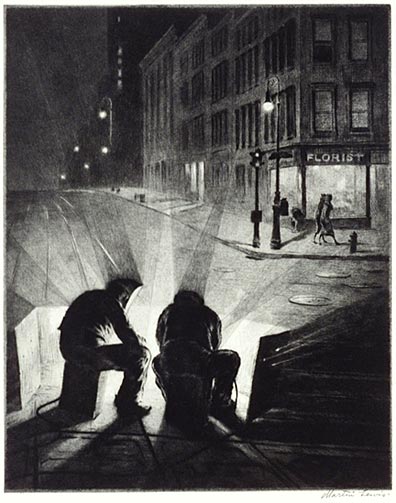Protest at the Detroit Institute of Arts

History was made on October 4, 2013, when hundreds of people gathered on the steps of the Detroit Institute of Arts (DIA) in Detroit, Michigan for a demonstration against city plans to sell the museum’s world-class art collection. The city has paid Christie’s auction house $200,000 to appraise the DIA’s holdings. The process is now underway to prepare for a massive auctioning off of the museum’s cultural treasures in order to pay down Detroit’s multi-billion dollar debt. The city’s appointed but unelected “Emergency Manager,” Kevin Orr, has repeatedly made clear that the option of selling the DIA’s collection is “on the table.”
A sizeable flying picket line of protestors gathered in front of the museum; they walked behind a large banner that read “Defend The DIA!” and carried homemade signs that read, “Don’t show me the money – Show Me The Monet,” “Gogh Away from the DIA,” and “Preserve the Picasso – Defend the Dali – Maintain the Michelangelo.”
Perhaps the most poignant handmade sign that I spotted was carried by a young woman, it read, “Hearts Starve as well as bodies, We Want Bread and Roses!” The sign was a direct reference to the Great Lawrence Textile Strike of 1912 carried out by mostly female immigrant workers in Lawrence, Massachusetts. Also known as the “Bread & Roses Strike,” the workers took their slogan from American poet, James Oppenheim, who had written the pro-labor poem Bread and Roses just a year earlier: “Yes, it is bread we fight for – but we fight for roses, too!” Oppenheim’s poem denoted that the fight for pragmatic necessities like jobs and decent housing is crucial, but the quest for beauty and the spiritually sublime is also essential to our wellbeing.
As more than a dozen drummers gathered at curbside and people chanted slogans like “Hey, hey corporate vultures, keep your hands off our culture!”, and “The working class is here to fight, culture is a social right!”, Auguste Rodin’s 1904 bronze sculpture The Thinker seemed to survey the lively scene from its granite base located on the steps of the DIA. Even the words chiseled into the stone facade of the museum contributed to the spirit of the day: “Dedicated by the People of Detroit to the Knowledge and Enjoyment of Art.” Video of the protest anonymously uploaded to Youtube shows the type of glorious activism in defense of art that I have advocated for years. I hope to see much more of this type of joyous but combative creative action in the months and years to come. It is long overdue in the United States.

I first wrote about the crisis at the DIA in a March 2009 post titled, Zombie Banks, Art Museums, & War. That was followed up by a June 2009 post titled, The Death of Motor City. As the economic collapse in Detroit escalated and the city threatened to auction the DIA’s holdings to pay down city debts, I wrote two major articles, Killing the Detroit Institute of Arts, and Defend the Detroit Institute of Arts.
Needless to say, I am heartened that the people of Detroit took to the streets on Oct. 4th to stand up for the DIA; I was there in spirit.
The protest to save the DIA was organized by the Socialist Equality Party (SEP) and its youth wing, the International Youth and Students for Social Equality. Largely coordinated and promoted on the SEP’s World Socialist Web Site, the party has closely followed the crisis at the DIA and has published innumerable insightful and informative articles on the matter; they have certainly dedicated more column inches to the subject than an other publication or organization that I can think of. The SEP has set up a dedicated website, DEFENDTHEDIA, from which they hope to maintain and enlarge their campaign.
As of this writing the protest has only been covered by a few Detroit media outlets: ABC Detroit, The Detroit News, MLive Detroit, Examiner.com, and CBS Detroit. It is telling that the “paper of record,” the New York Times, could not be bothered to report on the demonstration, despite the national and international implications of the story. Likewise, major dailies like the Los Angeles Times and the Washington Post have also ignored the protest. Notably but not surprisingly, the so-called art press did just as poorly, due no doubt to its general political apathy and postmodern detachment.
It was the alleged “left” press in the U.S. that possibly made the worst showing of all, which only fuels my general disdain for what now passes as a political left in the United States. During the course of this year self-styled “progressive” websites like The Nation, Mother Jones, Common Dreams, and The Progressive have not written a single solitary word concerning the possible destruction of the DIA and what this will mean for the American cultural landscape! Democracy Now, the vaunted flagship news and views show of the “progressive – liberal” Pacifica Radio network has remained completely silent regarding the Detroit Institute of Arts. Over the years these social democratic types have been droning on about what a threat the U.S. rightwing presents to the arts; it is an accusation that only serves to mask their own philistinism.

The general indifference concerning cultural and artistic matters displayed by the contemporary U.S. “left” make the efforts of the Socialist Equality Party all the more remarkable.
Critics may say the SEP is only attempting to recruit members, but organizing a defense of art and culture is not exactly the way to further an organization’s growth; art is not a “meat and potatoes” issue for most people.
The SEP has gone out on a limb to make the DIA, and broader cultural issues, a focus of their work: if only such a commendable stance was taken up by others – especially, from my perspective, by those professionals working in the arts.
But I am not making an argument meant to promote or otherwise advance the SEP, which is more than capable of doing so on its own. I have never joined nor endorsed any political party; you know, “artistic temperament” and all. I really enjoy being a contrarian and a totally independent artist, but I do admire the SEP for taking up the banner of the DIA and bringing some clarity, passion, and necessary visionary action to the fore.
Mary Harris “Mother” Jones (1837-1930), the American labor agitator and cofounder of the Industrial Workers of the World, once said: “If I can’t sing and dance in your revolution then I want nothing to do with it.” The faux “radicals” and art world hipsters that think the struggle to save the DIA is beneath them and a waste of time, should deeply contemplate the meaning of Jones’ famous quote. As for myself, I will continue to cover events in Detroit and beyond, and I shall carry on the “fight for roses, too.”

